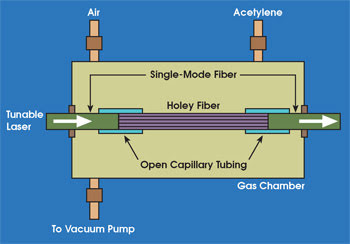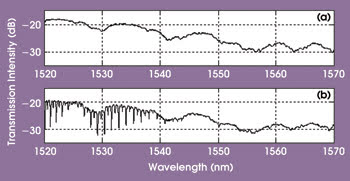Breck Hitz, Senior Technical Editor
Monitoring the gaseous emissions of processes, especially high-temperature processes such as coal combustion, is a continuing challenge to sensor designers. Fiber optic sensors have provided elegant solutions to many such challenges, but conventional optical fibers are problematic at elevated temperatures (≥1000 °C) because the dopants migrate between the core and the cladding, diminishing the fiber's waveguiding capabilities. Recently, scientists at Virginia Polytechnic Institute in Blacksburg demonstrated a fiber optic gas sensor that would be impervious to the high temperatures that disable conventional fibers.1
Holey fibers, sometimes known as photonic crystal fibers, have a system of tiny, longitudinal airholes in their cladding. These holes reduce the effective (average) refractive index of the cladding so that light is guided in the core by total internal reflection. (A different kind of holey fiber, sometimes called photonic bandgap fiber, depends on a quantum effect rather than on total internal reflection to guide light in the core.)
An advantage of holey fibers is that the indices of their core and cladding are not dependent on dopants and, therefore, are not subject to degradation at elevated temperatures. The airholes in most holey fibers are a periodic array, created by making a preform of a solid glass center surrounded by many hollow glass tubes and drawing the fiber from this preform.
The institute’s scientists have developed a different type of holey fiber, created by introducing a gas-generating powder into the preform and allowing the gas bubbles to be stretched into long, thin airholes as the fiber is drawn.2 In this case, the holes are random, not periodic, but they nonetheless reduce the refractive index of the cladding so that light is guided in the core by total internal reflection.

The transmission through the random-hole fiber was affected by evanescent-wave absorption of gas that diffused into the holes.
The gas sensor is based on evanescent-wave absorption by gas that has diffused into the airholes of a random-hole optical fiber. Because a random-hole fiber has more airholes and, hence, more surface area than a conventional holey fiber, the researchers believe that it can be a more sensitive evanescent-wave detector. They demonstrated the feasibility of such a detector by constructing a test chamber in which the transmission of a random-hole fiber could be monitored in the presence of different gases (Figure 1). Their experiment clearly showed the sensor’s ability to detect the presence of acetylene gas (Figure 2). They expect that similar results could be obtained with other gases, including NO2, CO, CO2 and H2S.

The measured transmission through the holey fiber in Figure 1 with air in the chamber (a) and when acetylene was introduced (b) indicates that the fiber is suitable for use in sensing applications.
A potential drawback of the new sensor is its response time. It took many minutes for acetylene to diffuse into or out of the random-hole fiber. The scientists suggest that the response time could be improved by increasing the size and number of airholes, and by tailoring the modal properties of the fiber to allow more interaction between the optical signal and the gas in the airholes. They also note that diffusion kinetics indicates that the response time will increase exponentially with temperature, so significantly better response time would be observed at elevated temperatures.
References
1. G. Pickrell et al (July 1, 2004). Random-hole optical fiber evanescent-wave gas sensing. OPTICS LETTERS, pp. 1476-1478.
2. D. Kominsky et al (Aug. 15, 2003). Generation of random-hole optical fiber. OPTICS LETTERS, pp. 1409-1411.